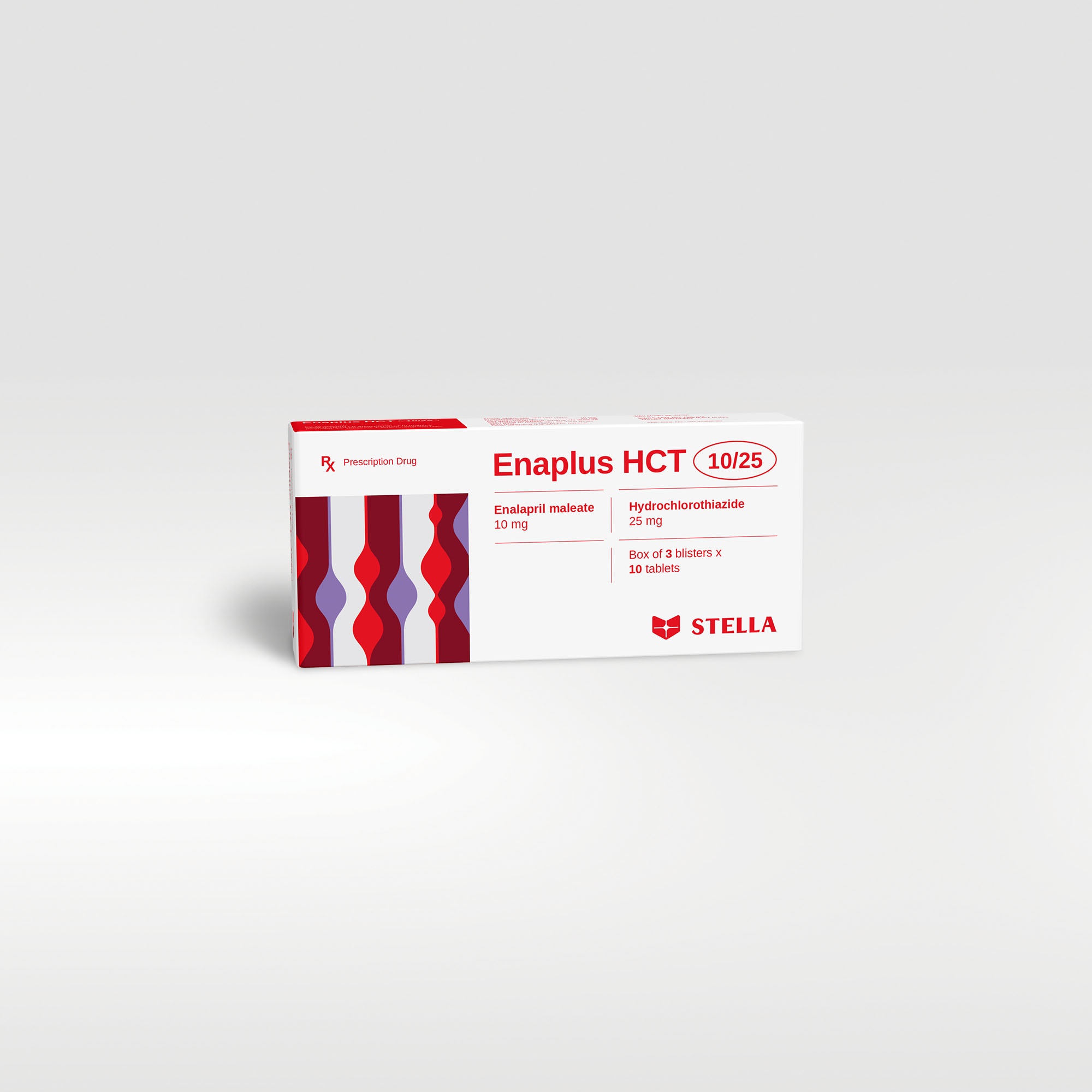Enalapril maleate – Hydrochlorothiazide
Hypotension and electrolyte fluid imbalance
- Regular determination of serum electrolytes should be performed in patient with volume-depleted.
- Special attention should be paid to patients with ischemic heart; cerebrovascular disease or severe heart failure.
Renal function impairment
- Enaplus HCT 10/25 should not be administered to patients with renal insufficiency (creatinine clearance < 80 ml/min. and > 30 ml/min.) until titration of enalapril has shown the need for the dose present in this formulation.
- If increase in blood urea and creatinine occurs, therapy with Enaplus HCT 10/25 should be discontinued.
Dual blockade of the renin-angiotensin-aldosterone system (RAAS)
- Dual blockade of RAAS through the combined use of ACE-inhibitors, angiotensin II receptor blockers or aliskiren is not recommended. If dual blockade therapy is considered absolutely necessary, this should only occur under specialist supervision and subject to frequent close monitoring of renal function, electrolytes and blood pressure.
- The combination of enalapril and a low-dose diuretic cannot exclude the possibility of a hyperkalaemia to occur.
- The combination of lithium with enalapril and diuretic agents is generally not recommended.
- Enaplus HCT 10/25 contains lactose. Patients with rare hereditary problems of galactose intolerance, total lactase deficiency or glucose-galactose malabsorption should not take this medicine.
- Safety and efficacy in children has not been established.
Enalapril maleate
- Caution in patients with left ventricular valvular and outflow tract obstruction and avoided in cases of cardiogenic shock and haemodynamically significant obstruction.
- Renal failure has been reported in association with enalapril and has been mainly in patients with severe heart failure or underlying renal disease, including renal artery stenosis. If recognized promptly and treated appropriately, renal failure when associated with therapy with enalapril is usually reversible.
- In patients with bilateral renal artery stenosis or stenosis of the artery to a single functioning kidney, therapy should be initiated under close medical supervision with low doses, careful titration, and monitoring of renal function.
- The use of enalapril is not indicated in patients requiring dialysis for renal failure.
- Treatment with enalapril is not recommended.
- Patients receiving ACE inhibitors who develop jaundice or marked elevations of hepatic enzymes should discontinue the ACE inhibitor and receive appropriate medical follow-up.
- Extreme caution in patients with collagen vascular disease, immunosuppressant therapy, treatment with allopurinol or procainamide, or a combination of these complicating factors, especially if there is preexisting impaired renal function. Periodic monitoring of white blood cell counts is advised and patients should be instructed to report any sign of infection.
- If concomitant use of enalapril and potassium supplements, potassium-sparing diuretics, or potassium-containing salt substitutes is deemed appropriate, they should be used with caution and with frequent monitoring of serum potassium.
- Closely monitor for hypoglycaemia, especially during the first month of combined use in diabetic patients treated with oral antidiabetic agents or insulin.
- Angioneurotic oedema of the face, extremities, lips, tongue, glottis and/or larynx has been reported. In such cases, Enaplus HCT 10/25 should be discontinued promptly and appropriate monitoring should be instituted to ensure complete resolution of symptoms prior to dismissing the patient.
- Caution in patients with a history of angioedema, patients receiving coadministration of ACE inhibitor and mTOR
- These reactions were avoided by temporarily withholding ACE inhibitor therapy prior to each desensitisation.
- These reactions were avoided by temporarily withholding ACE inhibitor therapy prior to each apheresis.
- ACE inhibitor-induced cough should be considered as part of the differential diagnosis of cough.
- Enalapril blocks angiotensin II formation and therefore impairs the ability of patients undergoing major surgery or anaesthesia with agents that produce hypotension to compensate via the renin-angiotensin system. Hypotension which occurs due to this mechanism can be corrected by volume expansion.
Hydrochlorothiazide
- Thiazides may not be appropriate diuretics for use in patients with renal impairment and are ineffective at creatinine clearance values of 30 ml/min or below (i.e., moderate or severe renal insufficiency).
- Caution in patients with impaired hepatic function or progressive liver disease.
- Thiazide therapy may impair glucose tolerance; decrease serum sodium, magnesium and potassium levels; decrease urinary calcium excretion and cause an intermittent and slight elevation of serum calcium.
- Thiazides should be discontinued before testing parathyroid function.
- Enalapril may increase urinary uric acid and thus may attenuate the hyperuricaemic effect of hydrochlorothiazide.
- Periodic determination of serum electrolytes should be performed at appropriate intervals.
- Thiazides can cause fluid or electrolyte imbalance. Caution in patients with cirrhosis of the liver, in patients experiencing brisk diuresis, in patients with inadequate oral intake of electrolytes and in patients receiving concomitant therapy with corticosteroids or ACTH.
- Hydrochlorothiazide contained in this product can produce a positive analytic result in an anti-doping test.
- In patients receiving thiazides, sensitivity reactions may occur with or without a history of allergy and bronchial asthma.
- Enaplus HCT 10/25 is not recommended during the first trimester of pregnancy. Contra-indicated during the second and third trimester of pregnancy.
- The use of Enaplus HCT 10/25 during breast-feeding is not recommended. If used, doses should be kept as low as possible.
- When driving vehicles or operating machines it should be taken into account that occasionally dizziness or weariness may occur.















